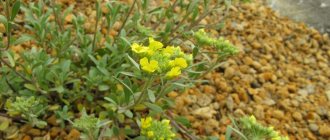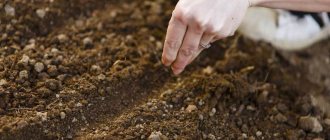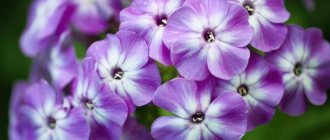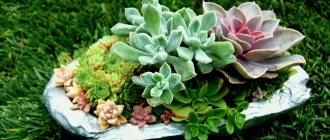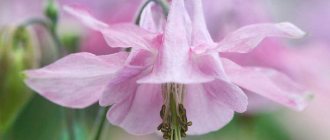Until recently, the Chlorophytum plant could be found in literally any house or apartment. It often decorated offices in various government agencies, hospitals, and schools. The thing is that people especially appreciated the unpretentiousness of chlorophytums, their amazing resistance even to difficult conditions. At the same time, the bush in most cases retains a neat and attractive appearance, no matter how bad it feels.
Dear readers! For you, we have created communities on social networks in which useful articles and interesting ideas are published several times a day! Subscribe and receive useful content in a convenient format!
Today, Chlorophytums are inexorably being replaced among the most popular indoor plants. They are being replaced by other exotic plants, but this does not mean at all that the time of Chlorophytums is irrevocably gone. Fans of these flowers even today find the process of growing these unpretentious evergreen bushes in pots interesting.
Indeed, the variety of Chlorophytum species, and about 200-250 of them are known only in the wild, will easily allow you to create an extraordinary decoration for any type of interior.
Caring for Chlorophytum after purchasing from a store
In general, Chlorophytum is a very unpretentious plant, so after purchase you can immediately begin replanting the flower in a permanent place.
On the other hand, it is recommended to wait at least two weeks after purchase without doing anything. During this time, you can make sure that the plant is not sick or infested with pests. In particular, during this entire period you should not feed Chlorophytum, as well as spray it and place it in bright sun. You also need to water it moderately.
After 2 weeks, it’s time to transplant Chlorophytum into a new container, since purchased soil is often very poor in minerals, which leads to stagnation in growth.
In a new pot, the flower must have completely new soil, and the container itself must be conducive to the growth of the root system, that is, be at least 3-5 centimeters larger in diameter than the purchased container.
By the way, you can treat the entire flower with a fungicide or insecticide for preventive purposes - this will prevent the development of diseases and the proliferation of pests when Chlorophytum’s immunity weakens in the first days after transplantation.
Growing conditions
Chlorophytums have always been highly valued for their high adaptability to indoor indoor conditions: dry air, relatively constant temperature throughout the year, limited nutrients in the soil, and ease of care.
On the contrary, it is more difficult for Chlorophytums to exist in the wild, because they tolerate high humidity less well, but geographically they grow precisely in tropical and subtropical regions where there is excess moisture for them.
BY THE WAY. Chlorophytum is famous for its ability to purify the air well. Therefore, it will not only decorate your home greenhouse, but will also be beneficial for the health of others. It is known that in the immediate vicinity of the Chlorophytum bush, up to 80% of pathogenic bacteria die. All this is thanks to the phytoncides that the flower releases into the environment. Three to four plants clean a room of up to 10 m2. They effectively absorb formaldehyde, carbon monoxide, and toxins that are dangerous to humans.
Therefore, for all varieties of Chlorophytum, there is practically no need to revise the care conditions established in the room where it will grow.
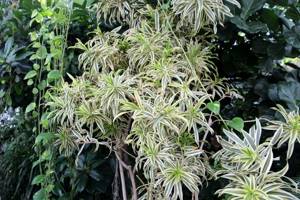
Chlorophytum in the wild
Temperature
In terms of room temperature, Chlorophytum is not very whimsical. He will be quite happy with the range of +15-25 Co. Do not need anymore.
In summer, the flower can and is even recommended to be moved to the balcony or open air (on an ongoing basis until late summer). However, it is only important to choose a place without strong drafts and not to allow large amounts of rainwater to fall on the foliage, otherwise the appearance of the bush will quickly deteriorate.
In the winter months, Chlorophytum will withstand even a strong drop in temperature in the room, but not for long. In general, this plant can be quickly destroyed only at a constant temperature below +10 C.
Air humidity
Chlorophytum has long been classified as a member of the Liliaceae family. But modern scientists classify this plant as Asparagus or Agave - opinions are still divided.
But all these families are characterized by growing in the wild in conditions of high humidity, although in fact, they require moisture within reasonable limits, no more. As for Chlorophytum, the frequency of watering is easy to work out. The soil in the pot should always be moist, but not too soggy, like in a swamp. On the hottest days, spraying will not hurt.
Dry air will certainly spoil the green cover: the leaves begin to dry first at the tips, and then all the way to the base. Therefore, sometimes you will need to humidify the air in the room. You can get by with a simple old-fashioned method - place a saucer of water nearby, which will gradually evaporate, naturally humidifying the air in the room.
It is especially important to pay attention to additional air humidification in winter, when the heating is on, drying out the room. It is for this reason, by the way, that Chlorophytum should be located at a distance from the batteries: at least 1.5-2 m.
Lighting
Remember that Chlorophytums, of all external care conditions, are the most picky about lighting. Their place should be illuminated with diffused light most of the day.
At the same time, the plant can withstand direct sunlight, but not more than a couple of hours a day, otherwise the delicate foliage will dry out quickly.
If you do not provide Chlorophytum with enough lighting, it will instantly wither and lose its healthy appearance. And if we talk about species that have variegated colors, then their leaves without proper lighting become standard, completely green without spots or patterns, that is, they lose their identity. On the other hand, when lighting is restored, the color quickly returns to normal.

Chlorophytum loves diffused light
Choosing a place to put a flower pot
It is believed that Chlorophytum feels almost ideal on the windowsill - where there is always enough light.
On the other hand, there may be little light on the north side, and too much direct sun on the south side. This gives rise to a logical conclusion: the best windows for placing Chlorophytum should face the western or eastern side. It will be light there most of the day, but the sun itself will not be too aggressive.
If I may say so, Chlorophytums are not averse to “taking a walk.” In the summer in the middle zone, they can be safely taken outside if conditions permit (for example, in a private house and your own yard). But you should choose the location more carefully: the flower will do well where there is no strong wind, and where rains cannot flood the root system, spoiling the appearance of the leaves.
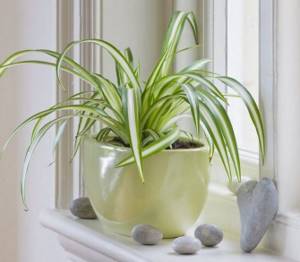
Chlorophytum on the windowsill
What are the benefits of chlorophytum?
Chlorophytum is not only a beautiful plant, but also a useful plant in every sense. It has been proven that its crown produces phytoncides that disinfect the air. It also absorbs fumes harmful to humans: carbon monoxide, formaldehyde, tobacco smoke. The green mass releases a large amount of oxygen and moisture, which makes the atmosphere in the room healthier.
Chlorophytum is accompanied by a number of superstitions and signs that say that the flower is very useful for home comfort and family happiness. This green fountain removes excess negative energy from the owner, relieves depression and helps solve problems in his personal life. Single people who have this flower in their home are more likely to find their match. Families will remain sensitive.
Flower growers know that most indoor plants must be isolated from pets, since their leaves contain substances that are poisonous to them. But cats can eat chlorophytum like regular lawn grass. Of course, the bushes may not become so beautiful, but this is definitely beneficial for the animals. They will receive the necessary substances and cleanse the body of hairballs.
What does it look like in the interior?
One of the well-known names of some varieties of Chlorophytum is “Splash of Champagne”. So it was deservedly nicknamed, because of the characteristic tails at the ends of the shoots, which resemble air bubbles flying in different directions. In any case, these types of flowers will greatly decorate the interior, because they look quite exotic.
But most of the remaining Chlorophytums are not the most eye-catching indoor flowers. They are characterized by an abundance of foliage and a large number of developing shoots, but the appearance is quite familiar and standard. For this reason, Chlorophytum is easy to combine with any indoor environment, from the most conservative classics in design to modern ones: high-tech, modern, neo-modern, underground.
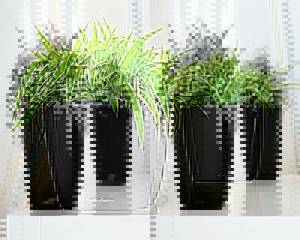
Chlorophytum in the interior
How to use chlorophytum in the interior of an apartment?
This culture is often used to make an apartment more attractive. The flower also has many positive properties. It is worth considering all these nuances in more detail.
Benefits for the home
Chlorophytum is often grown by florists at home. Moreover, you can often find several species at once in one apartment. Diversity allows you to create original interiors. When the babies hang from the main bush, it looks very beautiful. The same applies to crested chlorophytums. Orange ones are much less common.
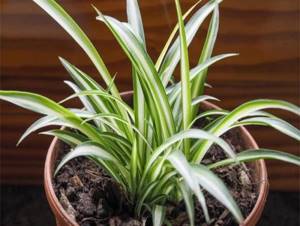
Regardless of the type of flower, it has many useful properties, these include the following:
- Purifying the air from harmful impurities and toxins.
- The plant is quite beautiful and decorates the interior.
- Indoor air humidification.
- Prevention of colds.
- Reducing the risk of developing allergies. If it exists, then its negative impact is suppressed.
This flower is often bred not only for its decorative qualities, but also for its beneficial properties. However, it is worth setting it higher if there are small children in the apartment. The fact is that its juice is poisonous to humans: if a baby bites a leaf, it can be poisoned.
Today chlorophytum can be seen in many institutions and apartments. The plant is unpretentious. The number of species is amazing, and new ones appear periodically. But this is already the result of the work of breeders. It is not difficult to propagate this crop, since after flowering a new flower always appears. Thus, this is an excellent opportunity for novice florists to practice growing indoor flowers.
Features of care at different times
Depending on the seasons, caring for Chlorophytum differs little from caring for most other indoor plants.
in spring
Spring is the time of awakening of a flower after a long winter. Already from the first days of March, Chlorophytum can be fed. First, mineral fertilizers are applied, then organic fertilizers. But you need to wait at least 2 weeks before each application of fertilizer.
In spring, you can also replant the plant if it has already outgrown its container.
It is recommended to carefully monitor the lighting. The more light there is, the faster Chlorophytum will begin to grow and form lush foliage.
In summer
In fact, in the summer months, all Chlorophytum care comes down to maintaining humidity.
The summer is too hot and dry - you can even water the flower up to 2 times a day, morning and evening.
If the humidity is high, then the average frequency of watering should be once every 1-2 days.
It will not be superfluous to frequently spray the leaf plates with a sprayer. This way it will be possible to maintain ideal air humidity and create excellent conditions for Chlorophytum.
In the summer months, it is permissible to continue feeding the flower at the same frequency as in the spring.
If conditions permit, Chlorophytum can be taken out into the open garden in the yard or on the balcony for the summer.
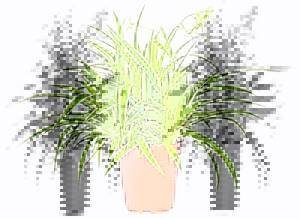
in autumn
If Chlorophytum was taken out onto the balcony or into the yard in the summer, then in the fall it should already be in the room due to cold nights (it is ideal to bring the flower home in mid-August).
In the fall, it is not recommended to feed the plant at all, and you should also begin to gradually reduce the intensity of watering. At first, you can irrigate the soil 2-3 times a week, and by late autumn it is enough to water once a week.
in winter
Chlorophytum should be watered little in winter (once a week, and sometimes less, depending on the condition of the soil).
Usually standard room conditions will be sufficient for the flower. It is only important not to allow the temperature to drop below +10 C when caring for a flower, but, obviously, such a cold snap occurs infrequently in heated rooms.
It is also not recommended to place the container with Chlorophytum close to the batteries (should be at least 1.5-2 m), and in case of wilting, use humidifiers.
How to grow chlorophytum at home?
You need to know how to properly grow a plant so that it feels great and blooms profusely. There are several recommendations from experienced florists. By following them, you can ensure rapid growth.
Temperature
This flower is considered unpretentious. It adapts perfectly to almost any conditions.
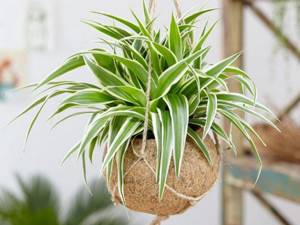
Here are some recommendations:
- the upper limit of the temperature regime is 27 degrees;
- lower limit - 18 degrees;
- changes of more than 5 degrees are undesirable.
Reference . The flower doesn't really like it when the wind blows around the room. There is a risk that the leaves will turn yellow and gradually wither.
Lighting
It is very important that the plant is comfortable. To do this, you need to provide proper lighting. The flower loves light, but is afraid of direct sunlight. Burns appear almost immediately. Therefore, diffused light is recommended.
Recommendations for choosing a location:
- it is better to place it in the kitchen, since chlorophytum loves a large amount of carbon dioxide;
- It is recommended to install not on a windowsill, but in a place with sufficient light;
- if there is not enough sun, the leaves begin to fade and growth slows down.
All this is important to consider when choosing a place for a flower.
Watering
It is very important to water this crop correctly. Here are some rules:
- The plant is moisture-loving, so it is better to overwater than underwater.
- The top layer of soil should be kept moist at all times.
- Frequent overwatering is harmful to the culture. In this case, the roots begin to rot.
- If for some reason the soil is dry, place the plant in a sink with water for about an hour so that moisture is constantly in the pan.
- When watering, it is necessary to supply water through the pan and from above.
- Periodic spraying of the crop with a spray bottle is highly recommended.
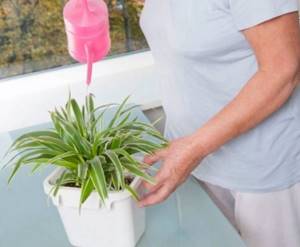
Reference . To make the plant feel better, use rain or settled water.
If watering is very abundant for a long time, the roots begin to rot. In this case, you need to urgently replant the flower. In this case, it is necessary to remove the rot and use a new substrate. Before transplanting, but after the flower is pulled out of the ground, the roots are dried for 3-5 hours. After this, the crop can be planted in a new pot.
Air humidity
Considering how much the culture loves water, it is logical to assume that it needs high air humidity. This is true. The optimal indicator is 80-90% . If the parameter becomes about 65%, then chlorophytum begins to slowly dry out. It needs more abundant watering.
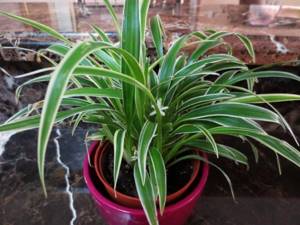
To eliminate growth problems, experienced gardeners install a humidifier in the room with plants. However, not everyone can afford it for various reasons. There is a cheaper solution to the problem. It is enough to place a container of water next to the pot.
Top dressing
It is important to periodically feed this plant. If there are enough nutrients, it will grow faster. However, we must remember that excessive feeding kills the crop.
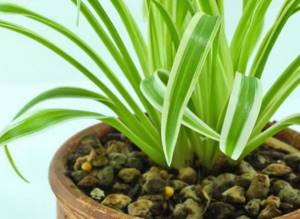
Here are the basic rules for feeding:
- Fertilizers should be applied from spring to autumn.
- It is necessary to use complex or universal compositions for indoor flowers. They should contain potassium, magnesium, phosphorus and superphosphate.
- You can make fertilizers yourself. For example, from banana peels, which are infused in one liter of water.
- The frequency of feeding is 2 times a month.
Reference . If a flower reacts poorly to feeding, then fertilizer is not suitable for it. You shouldn't continue to use it. It's better to try something else. You can find out which one is suitable only experimentally, taking into account the number of subspecies of chlorophytum. However, as practice shows, problems do not arise when using universal fertilizers.
When performing proper watering, not everyone remembers the need to apply fertilizer. In this case, it is impossible to achieve rapid growth and abundant flowering. Over time, the soil becomes depleted. Then the flower feels bad. It may die if a pot is purchased “for growth.” However, if you choose the right container, there are no problems. The soil changes every year. If it's from a store, it's fortified with nutrients. They are just enough for about 12 months.
Transplantation and how to plant?
It is necessary to replant the plant every year. The fact is that the root system grows quite quickly and becomes crowded. However, the new pot should not be too spacious. It is recommended that it be 2-3 cm larger than the previous one.
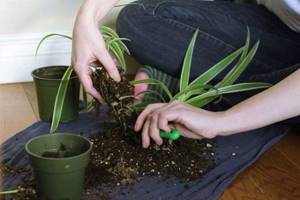
Plant transplantation process:
- In spring a new pot is prepared. If you have children and plan to plant them out, you will need several pots.
- Then separate the rosettes from the main chlorophytum using a sharp knife.
- First, the children are planted according to the boarding algorithm.
- Then you need to pull out the main plant and clean its roots from the substrate.
- Afterwards you need to inspect whether there is rot on the roots. If present, it is removed.
- Next, you need to plant the flower in a new pot and sprinkle it with soil.
Important . It is highly recommended to use store-bought soil. It is already enriched with nutrients and is completely suitable for chlorophytum. It is also disinfected, so there is no risk of pests.
If a flower is sick, you need to act quickly. He does not have a very strong immune system, which does not allow him to experiment. It is best to use fungicides. Industrial pesticides are used against pests.
When does flowering begin?
Flowering can only be achieved under the following factors:
- optimal conditions of detention;
- timely pruning;
- periodic feeding.
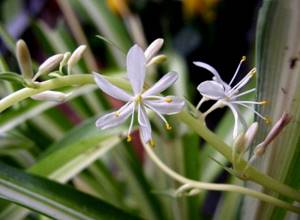
Flowering usually occurs from spring to autumn . In winter, the plant is dormant. Thus, you can see flowers only in the warm season, but for this you need to ensure that the culture is happy indoors. The flowering itself lasts about one month.
Root care
The root system does not require special care. However, several important factors must be taken into account, namely:
- replanting a flower every year;
- if there is rot, it is necessary to cut off damaged roots;
- if the bush is divided, then the cut site must be treated with antiseptics;
- When replanting, you need to be careful and carefully clean the root system from the substrate.

These are the main nuances that you need to remember when taking care of the root system. It is not recommended to add organic fertilizers. They will burn the roots and the flower will die. If there is a strong desire to use them, then the dosage should be small, and fertilizing should be done exclusively in liquid form.
How to care for young and adult plants?
In general, caring for a very young Chlorophytum bush or an already mature plant is almost no different.
Features can only be noted in the first days after purchase. It is recommended to quarantine for at least 2 weeks to allow the plant to adapt to the new conditions. To do this, water it moderately, do not feed it at all, and keep it in a cool place.
As it grows, it is also necessary to transplant Chlorophytum into larger containers. But since the formation of the root system in a flower occurs rather slowly (unlike green mass), this process is rarely resorted to.
Varieties and varieties
Basically, in home floriculture, only 5 varieties of Chlorophytum are most widely used, although more than 200 varieties are known in the wild. Other species, besides the popular varieties, are very rare and are found in greenhouses only by the most experienced gardeners, as they are more demanding to care for.
Crested Chlorophytum

Almost completely standard Chlorophytum with long, oblong leaves growing almost from the very root. In an adult and healthy state, the rosette of a bush can reach up to half a meter in diameter (that is, very lush).
A distinctive feature is that crested Chlorophytum shoots bare long shoots, at the end of which lush shoots with leaves or flowers (rarely) are formed. Thanks to this feature, such a flower is often compared to a fountain or those very “champagne splashes”.
Curly Chlorophytum
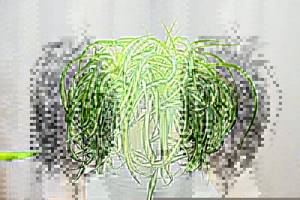
It is very different from the crested one in that it is noticeably smaller in size, its leaf plates are folded into neat spirals.
The leaves in the central part have a thin light stripe, which appears only in good light.
Winged Chlorophytum

A variety characterized by the presence of wide leaves with an orange color at the base.
This variety is considered decorative, as it rarely grows more than 50 centimeters in height.
Cape Chlorophytum
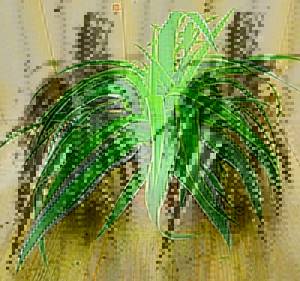
A flower that looks great thanks to its special leaf shape and color. With proper care, it can produce leaves up to half a meter long, although it itself looks quite short and compact.
Cream shades of the foliage border are truly rare, which is why they will invariably decorate the interior and attract attention.
Chlorophytum Laxum
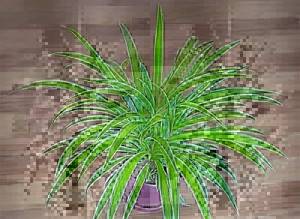
This is a very rare variety of domestic Chlorophytum, which grows to a small size, and the most remarkable part is the foliage. Laxum's leaves are thin, with white stripes on the sides.
Types of Chlorophytum
Several species of Chlorophytum are grown indoors. They differ in the color of the leaves, the shape and size of the bush.
- Chlorophytum crested. The most popular type. Easy to care for, ideal for growing indoors. It grows quickly, is easily propagated by daughter rosettes, they can be placed in water or immediately placed in the ground. The color is light green, there are species with white and cream stripes along the leaf. Tolerates shading, although diffused lighting is preferable. It can also grow in bright sun, but in this case the leaves become pale.
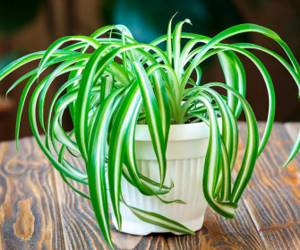
- Bonnie. Its striking feature is its curled leaves. Another name for Chlorophytum curly. The leaves are shorter than those of the classic variety. It is also unpretentious in care. An overgrown rosette looks interesting in the interior, especially if you plant it in a cascade in several pots.
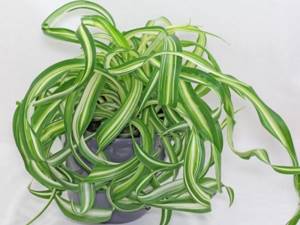
- Cape. Similar to crested, only the foliage is larger and wider, up to 80 cm long. It does not produce children; reproduction occurs by dividing the bush. Not very common in homes.
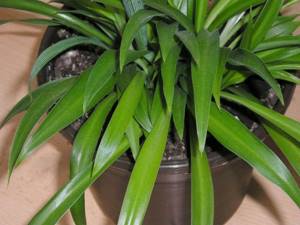
- Winged. It has wide leaves and looks very different from the usual appearance. There are no long peduncles, but there are seeds. It also reproduces by division.
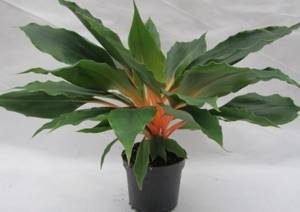
- Orange. One of the varieties of Winged Chlorophytum. The leaves are distinguished by bright orange petioles and veins. It is recommended to cut off the flower stalks so that the leaves retain their orange color and do not fade.
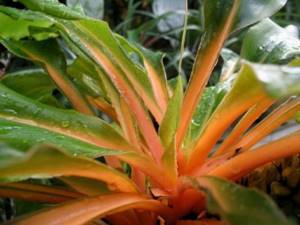
Transfer
There is nothing difficult with transplanting Chlorophytums. Firstly, this plant does not need it very often, but only as the container is filled with roots (this can be seen by the clearly stopped growth). Secondly, the process occurs through the usual transfer, that is, with the preservation of a clod of earth from the old pot and the addition of new fertile soil.
It is best to wait until early spring to transplant. Then you can sufficiently feed the plant and reduce stress for it, since a time of growth and enhanced root formation is expected ahead.
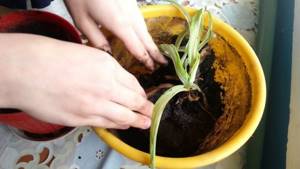
Chlorophytum transplant
Landing
To plant Chlorophytum, you can use any universal soil. You can either buy it at a specialty store or prepare it yourself. The main condition is that it be loose enough for the not very strong root system of this plant.
The pot should be lined with drainage or fine expanded clay or coarse sand. Ideally you need about 3-4 cm of layer.
You will need a saucer under the pot in which Chlorophytum will grow. For the first time after planting, fresh soil is well shed, and the excess moisture that has accumulated over time in the saucer is drained. For some time (namely, about a week) the flower is placed in the shade.
Chlorophytum - green filter
Agronomists cannot yet decide which family this plant belongs to. Some consider it a representative of lilies, others call it asparagus. One thing is certain - chlorophytum grows in tropical and subtropical latitudes. You can meet it near rivers and streams, in the lowlands, where the air is most humid! This “fluffy” flower is native to South Africa and also lives in Southeast Asia and South America.
Despite the fact that in our floriculture one species is more common (chlorophytum crested), in nature there are more than 200 of them. But even within one species you can find different colors and shapes of leaves. Most have drooping leaves collected in a root rosette. In favorable conditions, chlorophytum blooms with pleasure, forming small white flowers at the ends of arched stems. Bunches of leaves appear on these same stems. Over time, the plant forms a very lush bush!
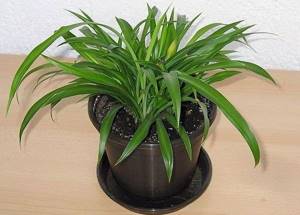
X. green
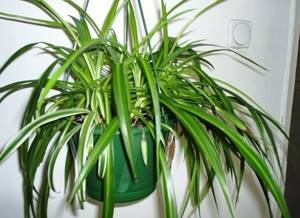
X. green
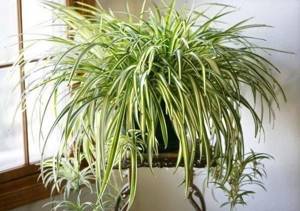
X. crested
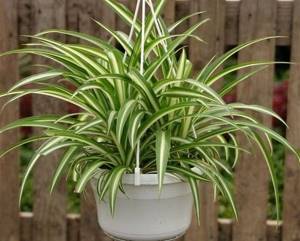
X. crested
The closest relative of the crested one is Chlorophytum curly Bonnie, its leaves resemble curls, this species is very decorative and grows quickly, forming branches with bunches of rosettes; it often blooms at home.
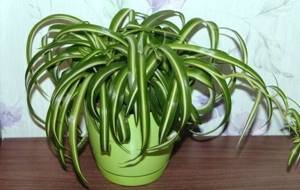
X. curly
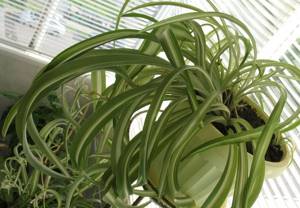
X. bonnie, photo by the author
Another popular variety is Chlorophytum cape. It is larger than its “brothers” and has narrow leaves with a white border. The girth of the bush can reach 70-80 cm, it is considered the largest of its kind! Another feature that distinguishes this species is that it does not form daughter rosettes.
✿
Reproduction
There are several effective ways to propagate Chlorophytum. All of them are familiar and classic, relevant for all indoor flowers:
- Dividing the bush.
- Rooting rosettes at the root.
- Seeds.
Reproduction method by dividing the bush
This option can be chosen for those bushes that have grown greatly. Then, using a sharp knife, they are divided into several smaller bushes, and the cuts are treated, for example, with charcoal (so that they do not rot).
After this, each new sprout is planted in a separate bowl.
Rooting rosettes and shoots
Here it is important to choose a strong root shoot or cutting that grows from the main rosette at the base.
At first, the shoot is placed in a glass of water. Later, when the root system is formed, the cuttings can be planted in the first small container with soil. The soil, by the way, will need to be nutritious and rich in minerals (can be used with fertilizing).
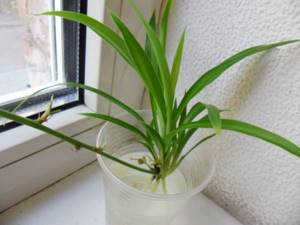
Reproduction of Chlorophytum
Seeds
There are varieties of Chlorophytum that can only be propagated by dividing the bush or by seeds, since cuttings are not formed on them.
If you choose the seed method, then the cultivation steps are quite standard. First, purchased seeds must be soaked in water at room temperature for at least a day. You can add the growth stimulator Epin to it.
After this, plant the seeds in a container with sand and peat soil, pressing them in slightly. Spray the planting with a spray bottle and cover with cloth or film.
The container should be left in a warm (+22-26С) and well-lit place. When Chlorophytums with at least 3 formed leaves sprout, they need to be transplanted into small containers one at a time.
A little later, when the plants take root and grow, they are planted in a permanent place.
Watering
The tactics for watering Chlorophytum can hardly be called complex.
- In spring and summer, during the period of active development of the root system and foliage, the flower should be watered abundantly. On hot days, the intensity of watering reaches once a day (and in extreme heat even twice a day).
Water the flower either early in the morning or in the evening after sunset.
- In the cold season, the frequency of watering should be reduced. The minimum intensity is usually recommended at 1 watering per week. However, it is worth constantly monitoring the condition of the soil in the pot - it should be moist and not dry out too much.
Chlorophytums also respond well to spraying from a spray bottle. If you do this constantly, every day, you can achieve especially rapid flower growth.
ADVICE. Some varieties of Chlorophytum love spraying, but in order not to spoil the appearance of the foliage (or rather, to protect it from the appearance of stains, stains and putrefactive formations), it will be useful to wipe off excess drops from the leaves after each spraying.
Top dressing
There is no consensus on feeding Chlorophytum. There are those who quite rightly claim that for proper care, the flower needs to be fertilized once a year - in early spring. It is worth recognizing that there is some truth in this, since Chlorophytums are extremely unpretentious to the mineral composition of the soil. They literally can grow calmly in soil of normal composition.
On the other hand, it is difficult to argue with the fact that for intensive flower growth, mineral fertilizers and nutrients must be present in sufficient quantities in the soil. Therefore, those who want to grow a Chlorophytum bush faster and achieve a healthier, fragrant appearance should add additional fertilizing to the soil.
As a rule, you can buy standard mineral complexes for indoor plants and alternate them with conventional organic fertilizers.
Fertilizers should be applied no more than once every two weeks. The feeding period begins in early spring and continues until the end of summer.
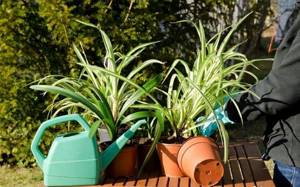
Watering and fertilizing chlorophytum
Conditions for proper flower development
Optimal development will occur if the plant is provided with the best environmental conditions. If you follow all the recommendations, you will get a beautiful bush with beautiful leaves.
Follow these rules when growing chlorophytum.
| Aspect | Description |
| Light mode | Orange chlorophytum grows without problems both in the sun and in the shade. However, if the shadow is too strong, the crop will stretch upward, and the petioles will lose their beautiful appearance and aesthetic value. The sun's rays should not burn the plant, their influence should not have a negative effect. The plant loves the sun, but in the summer after lunch it is advisable to protect the bush from light. Chlorophytum can also exist in partial shade, but in such a situation its unusual color will fade. In the summer, it is not advisable to move the flower pot far away - it loves to be in the fresh air. If possible, you can place the flower in the shade of trees. |
| Temperature | As for the temperature regime, we can say that orange chlorophytum prefers warmth. The best temperature for good development is 25-27 degrees. In winter, the permissible temperature can be lowered to 20-22 degrees. In some situations, it is advisable to keep the plant at a temperature of 15 degrees Celsius, but chlorophytum should not be kept in such conditions for a long time. A slight change in temperature will have a good effect on the bush, but a long stay in the cold will negatively affect the immune system. |
| Location | The best location for a flower pot should be comfortable so that the plant can stay there for a long period without any problems. Chlorophytum should not be placed on a windowsill where cold drafts are frequent. These conditions negatively affect it and provoke illness. In summer, it would be advisable to place a flower pot in the fresh air. For this purpose, a balcony or veranda is used. Fresh air accelerates the growth of chlorophytum, making its characteristic colors even brighter. |
| Humidity | Orange chlorophytum does not require high humidity; it is allowed to occasionally spray it with water in the summer. However, this must be done in such a way that during the spraying process it is not in direct sunlight. This will cause sunburn on the foliage. |
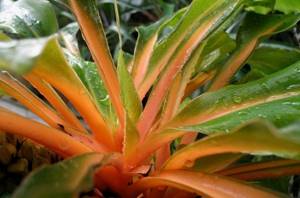
To grow a healthy flower, you will have to make some efforts to create conditions suitable for it.
It is very important to provide the plant with lighting adequate to its requirements. Orange chlorophytum needs control
The reason is that when a flower is exposed to direct sunlight for too long, its leaves will be scorched and the color will fade. Otherwise, a long shadow can affect the shade of the cutting or edging - they lose their characteristic orange color.
Diseases and pests
It is well known that Chlorophytum has good immunity, which is especially resistant under good room conditions.
Occasionally you can find damage to a flower by insects such as scale insects and aphids. Thrips infections are even less common. As a rule, all problems disappear after treatment with insecticides in accordance with the manufacturer's instructions.
And in order to prevent the recurrence of the disease or the rapid return of pests, reduce soil moisture. Almost always the problem lies in excessive dampness.
Common mistakes
Chlorophytum foliage darkens - most likely this is a sign of some kind of physical damage. In rare cases, the problem may be too high a temperature or too much humidity.
Monochromatic leaves grow on variegated chlorophytum - in most cases, a sign of a serious lack of light. The problem goes away very quickly after changing the location of the pot.
The formation of rot is almost always associated with stagnation of liquid in the pot. They get rid of rot by significantly reducing the intensity of liquid application. By the way, sometimes rotting in Chlorophytums begins due to an incorrectly selected soil mixture - too dense a structure leads to flower diseases.
The tips of the leaves are fading - this means that the plant clearly does not have enough moisture. But this does not necessarily apply to watering. Sometimes this painful appearance is caused by too dry air in the room.
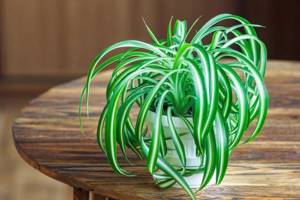
Possible problems in growing chlorophytums
Problems and illnesses arise due to improper care or lack thereof. The plant is resistant to various diseases and pests, but errors during cultivation and negligence of the flower owner can worsen its condition. If the necessary treatment measures are not taken in time, the plant may die.
Often problems arise due to the characteristics of the variety, and sometimes, on the contrary, the variety has advantages in its cultivation. For example, when caring for chlorophytum curly at home, gardeners do not face the problem of pests. The fact is that the flower has a high antibacterial property, which repels parasites.
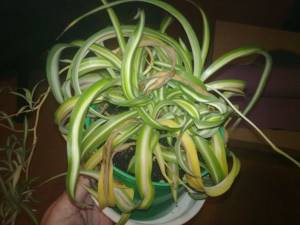
Yellowing of leaf tips
The tips of chlorophytum leaves dry out
Flower growers often wonder why the tips of the leaves of chlorophytum begin to dry out. But not everyone notices that before the plant dries out, it shows that it is sick. At first it begins to weaken, has a sluggish and unhealthy appearance, and its growth slows down. Then the tips of the leaves begin to turn yellow.
Reasons for yellowing of chlorophytum leaves:
- When planting, ordinary soil without fertilizers was used. As a result, the plant does not have enough nutrients for healthy growth. It is necessary to fertilize with complex fertilizers, the purpose of which is to saturate the soil with the necessary mineral and organic substances. In spring, it is necessary to transplant the flower into a nutrient substrate. The drug is administered according to the instructions and the recommended dose prescribed on the package;
- increased dryness in the room where the flower is grown. It is necessary to frequently ventilate the room without allowing a cold draft. To increase humidity, the number of waterings and sprays is increased and a container of water is placed next to the plant;
- the room temperature is increased. The problem is dealt with in the same way as dry air. On hot days, the plant must be placed in a cool, dark place;
- mechanical damage. Perhaps, due to carelessness, the flower was damaged when it was moved to another place or the root was damaged during loosening;
- no transfers. The root has grown and is cramped in a small pot.
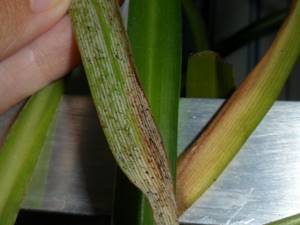
Flower leaves may turn black
Why do chlorophytum leaf tips turn black?
Improper care of chlorophytum leads to another problem - blackening of the tips of the leaves. First, the leaves become covered with brown spots and turn brown, then begin to turn black. The main reason for this behavior of the flower is excessive soil moisture or lack of loosening, which causes stagnation of moisture in the soil. In winter, watering the flower should stop so that it can rest.
Note! The leaves also turn black due to hypothermia, so you need to move it to a lighted and warm place. You can grow healthy chlorophytum at home with proper care.
The plant, in addition to its beautiful decorative appearance, has beneficial properties and is valued among gardeners. The beautiful flower fights bacteria and germs in the air, making it an ideal indoor plant in a child's room.
You can grow healthy chlorophytum at home with proper care. The plant, in addition to its beautiful decorative appearance, has beneficial properties and is valued among gardeners. The beautiful flower fights bacteria and germs in the air, making it an ideal indoor plant for a child's room.
Answers to popular questions
Why do the leaves/shoots turn black or dry?
The very first reason is improper watering. Basically, this means that the plant is not getting enough moisture. Another common reason is that there is not enough space in the pot for the root system.
Why did the leaves droop?
This process also has natural reasons. For example, Chlorophytums lower their foliage slightly at night due to lack of light. But if the phenomenon is permanent, then most likely the flower is cold (room temperature +10 C or less).
Chlorophytum not blooming?
This is a double-edged sword, because everything depends on the variety. Very often it is really difficult to achieve Chlorophytum flowering. But if you choose a variety with constant flowering, then it is important to understand that young plants do not bloom for a long time. They need 2-3 years to reach adulthood.
What to do if the roots rot?
Basically, the main reason lies in poorly permeable soil. The situation can be corrected only by transplanting the flower into the correct soil (in this case, emergency measures are needed, so replanting can be done not only in the spring, but also at any other time of the year).
Why has growth slowed?
Perhaps the reason for everything lies in the small pot. Sometimes growth slows down if the flower lacks light or moisture.
The leaves are the same color, what should I do?
Variegated species can indeed sometimes grow with completely green foliage, losing their identity. Almost always, the main reason for this phenomenon is a lack of lighting. You should change the location of the plant or organize artificial supplementary lighting.
Growing and caring for chlorophytum
This amazing flower does not require any special soil; any soil will suit it. The same goes for choosing a pot. It grows superbly both in rooms with bright sunlight and in shady areas. Not afraid of either high or low temperatures. Feels great on a nightstand or in a flower pot on the wall. In a word, this is a godsend for lazy people, or people who sorely lack time to grow indoor plants.
Note! For leisure activities, we recommend visiting the handicraft portal for beginners https://gidrukodeliya.ru - a large selection of exclusive ideas is presented here.
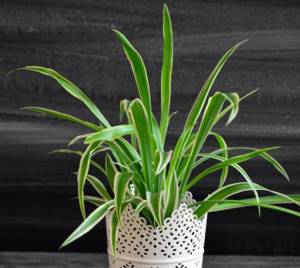
What is also interesting about chlorophytum is its unpretentiousness to watering. If you don’t water it for a long time, up to a month, it won’t die, just the leaves of the chlorophytum will become a little sluggish, and if, on the contrary, it receives excessive watering, it will grow a gorgeous root system with shoots in the form of arrows, which makes it even more attractive.
Read here Cordyline - 155 photos of the main species for home cultivation. Video advice from experts on maintaining ornamental plants
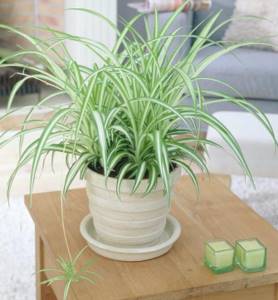
What are his escapes worth? They are miniature copies of the mother bush, attached to the ends of dense twigs going down.
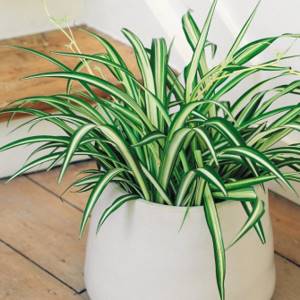
Thanks to excessive watering, the root system does not rot, but rather expels many additional leaves to get rid of excess moisture.
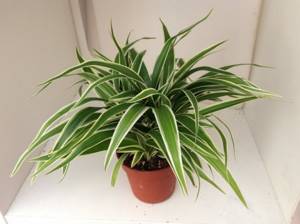
In a word, having got chlorophytum at home, you can safely go on vacation or on business trips; it will always wait for its owner at home.
Conclusion
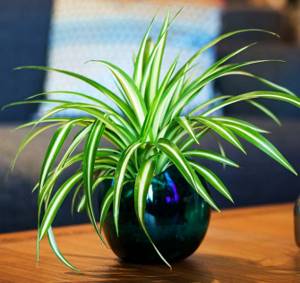
Chlorophytums are surprisingly unpretentious indoor plants and this is perhaps their most important advantage. This is what explains their great popularity, which even today has fallen, but is still high.
Chlorophytums are perfect for growing for beginners. But professionals will also be able to find a lot of interesting things for themselves if they give preference to rarer, more care-demanding, exotic varieties.
